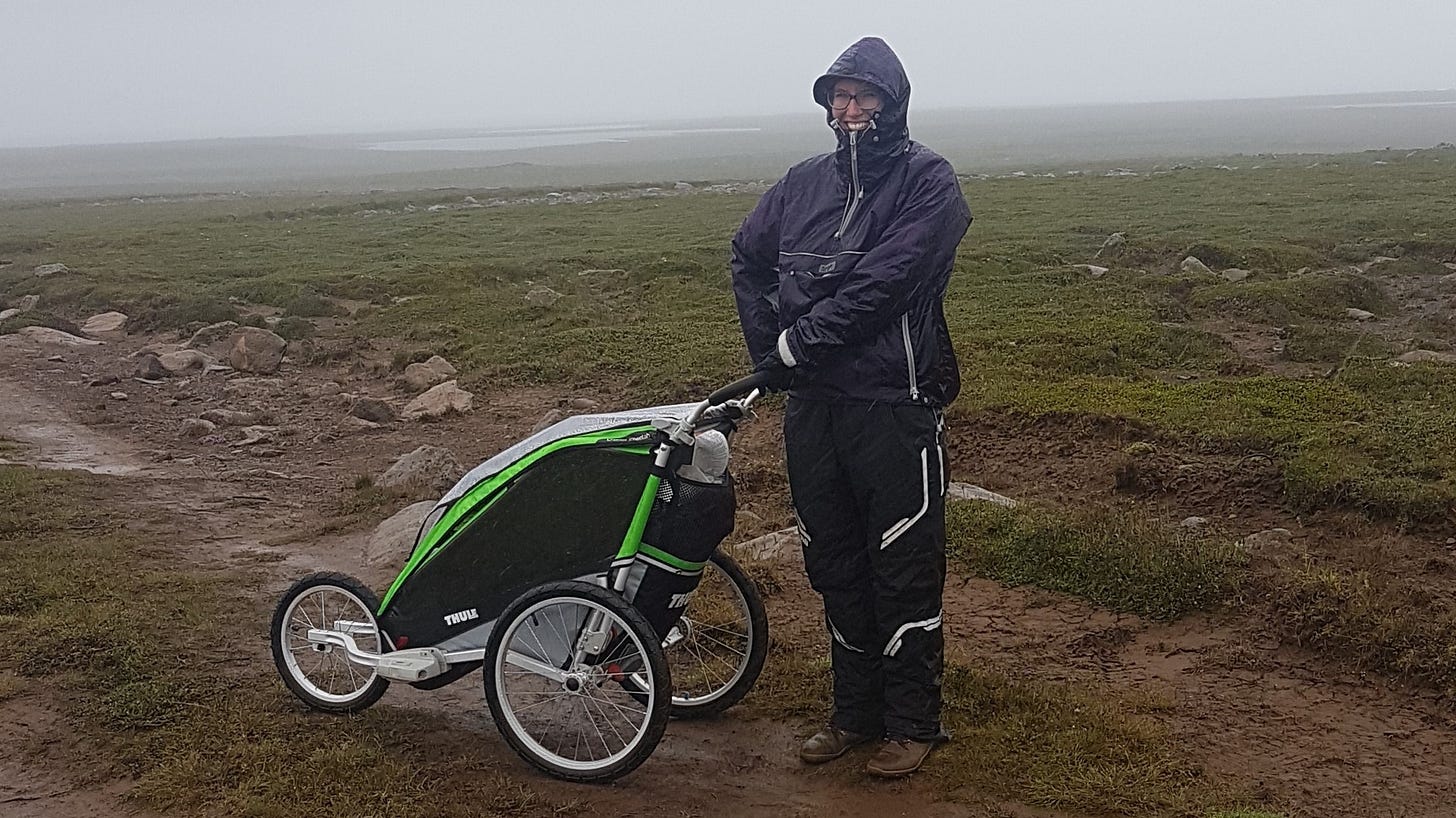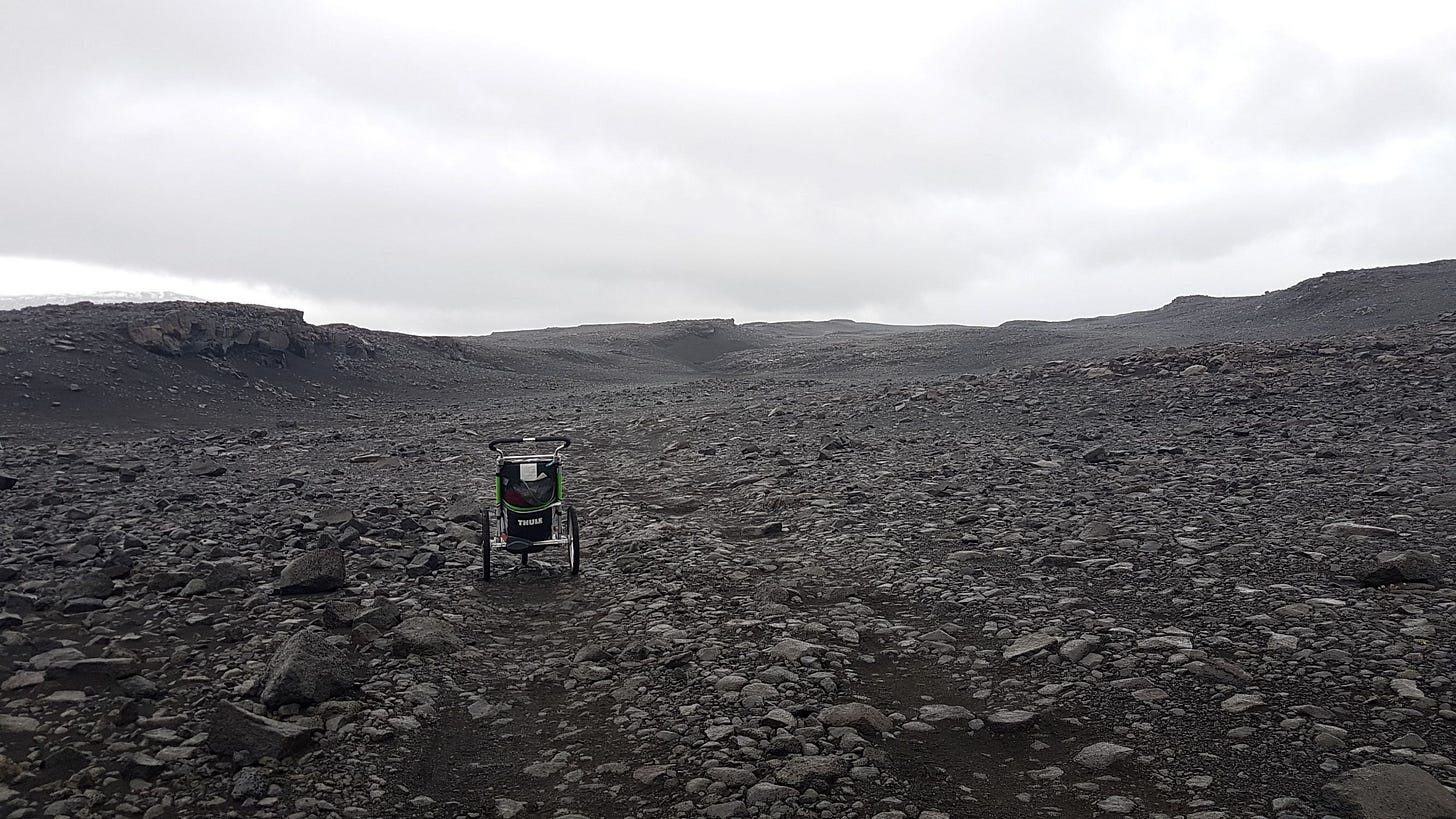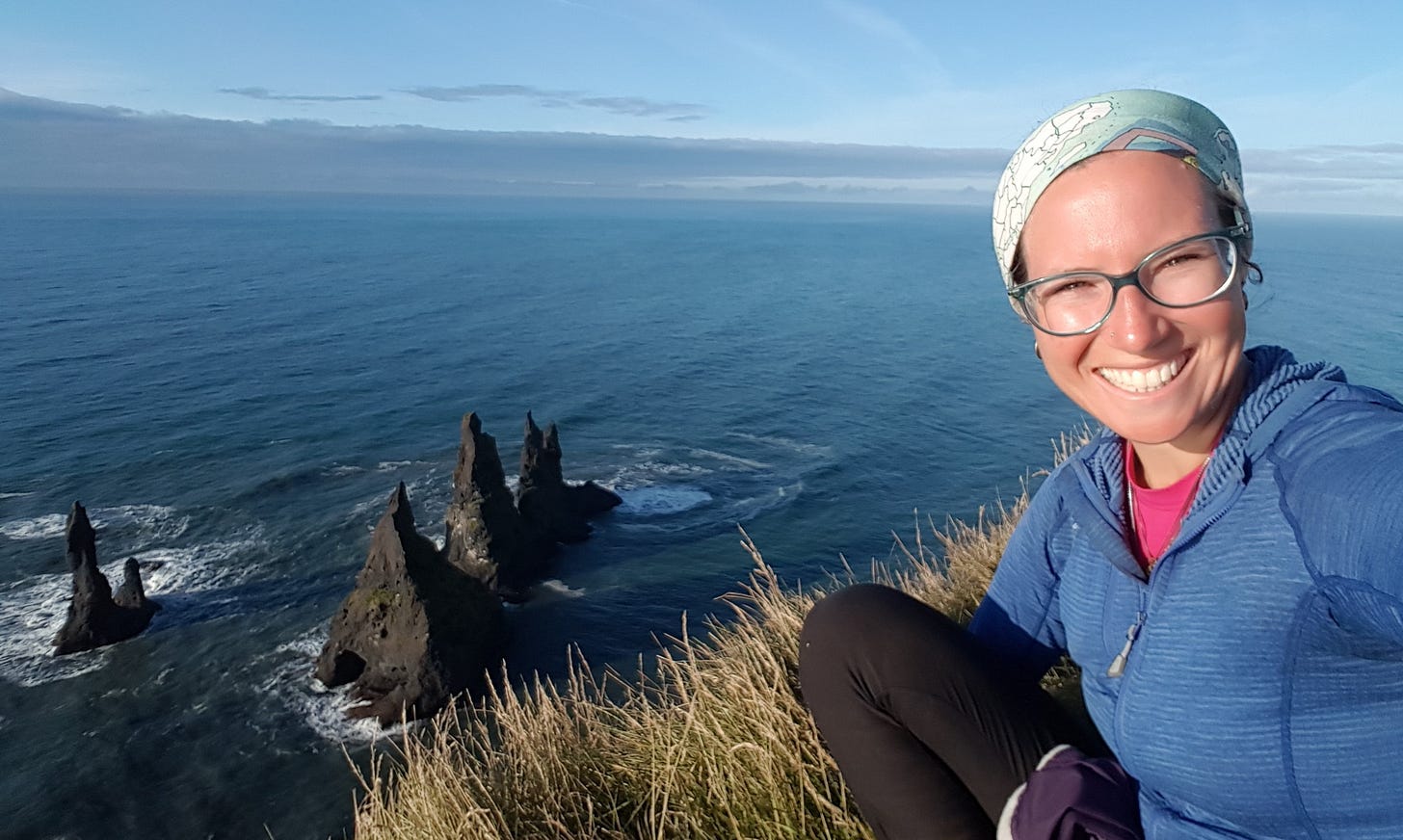Across Iceland Solo with a Buggy
Alice Bowers crosses Iceland by foot, with only a buggy named Jake for company.
I’m standing on the main road leading north out of Húsavík, a small, rather grey fishing town in the north of Iceland. It’s 11am, my thumb is out and it’s drizzling. I hop from one foot to the other, a wide smile for every car that passes, but for some reason it isn’t working. In fact, I’ve been standing here for over an hour.

Finally, a truck pulls up and I rush over. “You got a baby in there?” an Icelandic accent enquires. I look behind at my buggy, ‘Jake’, full to the brim with over twenty days of food and camping equipment. It quickly dawns on me why no one is stopping. “I can’t help, but if you're still here at 6pm you can stay at my place.” I smile and thank him, thinking internally, “6pm! Does he think I’ll still be here in seven hours?”
Deciding on drastic action, I empty Jake, fold him up and dump my stuff on top. The plan works and ten minutes later I’m speeding off to my start point: Rifstangi Peninsula. The beginning of my 610km walk, from the northernmost to the southernmost point of the Icelandic mainland.
The first five days were spent rambling along smooth gravel tracks, surrounded by boggy moorland and small farmsteads. There was either a campsite or shop en route each day, and at one point I ended up in an open-air swimming pool. It rained constantly, but ever the optimist, I decided it was good practise for learning how to keep dry. Soon though, the safety of the inhabited north came to an end and the tephra wastelands and endless ash deposits of the interior began. I was filled with both excitement and nerves; the next section of paved road wouldn’t be for another 350km.
I needn’t have worried. For the first time in a week, the sun came out and I walked with a sense of total freedom and joy. The huge distant mountains, fast-flowing rivers and never-ending black sands were breathtaking. Roughly ten-twenty vehicles passed by a day, all headed towards Askja caldera, an active volcano. Occasionally these vehicles would stop; curious tourists wondering what I was up to, proffering gifts such as a much-appreciated chocolate bar or, at one point, a boil-in-the-bag sticky toffee pudding!
Eventually, I reached ‘Dreki’, a small campsite and hut set-up, at the foot of Askja. I really wanted to visit the crater and its geothermal lake ‘Viti’, but the 16km round trip would take up a whole day. Time I couldn’t really afford, due to limited food supplies. Instead, I looked for a lift and got lucky. An Icelandic tour guide, Ingi, and his father-and-son clients agreed to take me to the top in their jeep. Upon reaching the lukewarm waters of Viti, Ingi stripped off completely and ran in. “It’s the Icelandic way!” he shouted, leaving me and the teenage son changing sheepishly on the lakeshore. Afterwards, I quizzed Ingi about his job, “Have you ever had a complaint from a client, you know, about ‘the Icelandic way’?” He smiled, “Only the one time, an American woman and her daughter didn’t like it too much.” I couldn’t help but chuckle, sometimes cultural differences can be quite funny.
The next 125km were the most remote of the whole trip. Not many vehicles travel south of Askja, due to potentially deep river crossings, turbulent weather and unmaintained tracks. I made sure to speak to the wardens at Dreki before departing, and they informed the warden at Nýidalur (the next set of huts) that I was on my way, setting a time frame of five days in case of bad weather. I knew that roughly 65km in there was a hut, ‘Kistufell’, that would be a good place to shelter if the weather turned.
The first 35km out of Dreki consisted mainly of 5cm-deep black sand. Unsurprisingly, I discovered that pushing a heavily laden buggy through sand was not a simple task. That said, the views of the vast Vatnajökull ice cap in the distance served as good motivation to keep going. After two full days of pushing, I arrived at the battened-down door of Kistufell, intent on spending the night within its snug confines.
The interior was a cosy set-up with bunk beds, blankets and a chair and table. I made myself comfy and listened to the wind howl through the night. A storm had come in. I tried to leave the next morning, but was instantly battered by wind and sand. The heavy wooden panels, used to board up the windows and doors, had been blown about ten metres away and I had to drag them inside, fearing that otherwise they could damage the building.
The next morning appeared slightly calmer and I decided to resume walking. Big mistake. It wasn’t long before the winds picked up and sand ripped and whirled across the plains. My eyes streamed, leaving black ash clinging to the damp patches on my face. Feeling defeated, I scoured the landscape for a sheltered spot to camp and set up behind a large volcanic boulder. It was clear that the tent pegs weren’t going to hold for long and I rock-walled the tent in, hoping that, combined with my body weight it would be enough ballast to last the night.
I awoke, feeling less than refreshed but keen to get a move on. It was now day five since leaving Dreki and I wanted to make the 45km to Nýidalur by nightfall. According to the map the day wouldn’t be easy, with six different river fords along the way. Most were fine, little more than shin deep and without much flow, but one was trickier, reaching my thighs at some points and with a much stronger current. About three quarters of the way across Jake got caught in the flow, creating a drag which threatened to pull me downstream. I heaved and strained my body weight towards the bank and made it across, buggy still in hand, but noticeably shaken. Dusk was settling as I finally arrived at Nýidalur, and I was relieved to see the warden. I hadn’t seen anyone in days.
Setting off again, I was aware that the scenery in and around Askja had spoilt me a little. What would have been spectacular just two weeks before was now the norm, and it’s difficult to admit but at times I found it slightly dull. I had a new target in mind though: waffles. By this point, I had eaten something like 35 packets of noodles (I fully expected to develop scurvy) and was craving the sweet stuff. It was for this reason that I took a 25km detour to the Hrauneyjar Highland Centre. At £170 a night I wouldn’t be staying, but I could definitely wash in their bathroom and eat waffles. You had to remove your shoes before entering, so I self-consciously walked in wearing my socks, knowing they hadn’t been washed in days and most definitely stank. The waffles were totally worth it though, so good I had two portions washed down with hot chocolate. I just hope I didn’t put the other customers off their food.
My trip was now nearing the end, and I had saved some of the best hiking till last. The Laugavegur and Fimmvörðuháls trails are two of the most popular in Iceland, and for good reason: the views are stunning. The difficulty was that Jake wouldn’t be able to come with me. He had done a gallant job in the previous weeks but I didn’t fancy pushing him up 30-degree slopes. Instead, he was left in a tool shed and I donned my backpack and continued on alone. The variety of the trails didn’t disappoint; obsidian lava fields, colourful rhyolite mountains, geothermal springs, glaciers and proper snow. It was basically hiking paradise; the perfect place to process the last few weeks and accustom myself to socialising again.
The last day arrived, and with it, an attempt to get a bit more off the beaten path. It didn’t go quite to plan, and after weeks of managing to stay relatively clean, I ended up bottom deep in bog, covered in slimy farm run-off. For some reason, it seemed fitting that I would finish as filthy as possible. Finally, the edge of the Reynisfjara peninsula came into view and I could see the shimmering surface of the Atlantic Ocean. I was overjoyed; it had been 23 days since I’d last seen the sea, and it was amazing to think of all the experiences and memories created in the space between. Most of all, I had appreciated the pure simplicity of solitude; the uncomplicated act of putting one foot in front of another, free from the complexities of modern life. The adventure wasn’t over yet though, I still had to get Jake back from the tool shed!
Alice Bowers has spent the last five years pursuing people-powered adventures around the globe. Including cycling for thirteen months in SE Asia and Australasia, attempting to packraft the length of Bangladesh and walking the length of Iceland.
If you fancy completing a similar journey, you can find logistical information on her website: www.alicebowers.com






